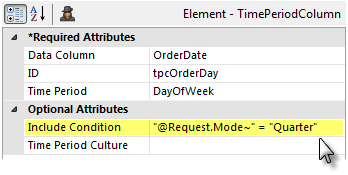Time Period Columns
Developers frequently need to work with parts of dates and timestamps and often employ various string parsing techniques to do so. The Time Period Column element, described in this topic, allows you to directly access the date and time parts of data without resorting to JavaScript functions and complicated parsing.
The following topics discuss the Time Period Columns element:
- Time Period Column Attributes
- Time Period Column Simple Usage Example
- Time Period Column Advanced Usage Example
About the Time Period Column
The Time Period Column is similar to other elements designed to extend the data available in a datalayer. Like the Calculated Column element, the Time Period Column is added as a child element beneath a datalayer and adds a new column to the datalayer. This column contains derived data which is accessible using an @Data token. In this case, the derived data can be any of the parts of a DateTime value.
Time Period Columns can also be configured to be culture-aware so that the values derived will agree with the culture settings of the user's browser.
Dynamic Application
The Time Period Column element has an Include Condition attribute:
If the value of this attribute is left blank or contains a formula that evaluates to True, the element is applied to the datalayer. If the value evaluates to False, the element is ignored and does not affect the datalayer. This powerful feature allows developers to dynamically determine if the Time Period Column will be added to the datalayer or not.